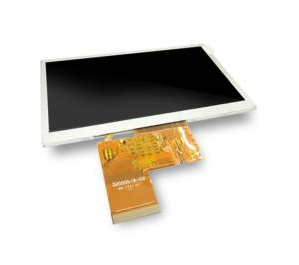TFT LCD – DRIVER IC & INTERFACE
Blaze Display Technology Co., Ltd. | Updated: Nov 27, 2018
TFT LCD is becoming the norm for small-to-medium size displays in a variety of products within industrial, medical, POS and consumer applications. Compared to passive-addressed monochrome LCD, TFT displays offer higher contrast, wider viewing angles, faster response time and full color. And, TFT LCD is now on cost parity with similar size passive LCD displays.

A typical TFT LCD module product consists of a TFT LCD panel, one or more COG (chip-on-glass) driver IC, a backlight unit, and an interface FPC. Several TFT display interface technologies coexist today. Picking the right technology depends on specific end-product concerns. Most often the display panel input will dictate that choice since TFT panel is designed to be COG bonding pad compatible with a very limited number of driver IC. Typical TFT interface is determined by the particular TFT panel size and resolution:
1. Up to 3.5” size with 128×160 to 240×320 resolution – normally have SPI, parallel MPU or RGB interface
2. Between 4.3” and 7” sizes with 480×272 to 800×480 resolution – mostly have RGB interface
3. For mobile displays with a resolution higher than 480×854 – the normal interface is RGB, MIPI or LVDS
4. For 7” size and above with 1024×600 and higher resolution – normally have LVDS or MIPI interface
5. HDMI and EDP require interface converting boards and generally are not used for small-to-medium size TFT LCD
SPI Interface: Only the three SPI signals, a CS and a reset signal are needed. Drawbacks are the inability to read from the display, only write. Also, the frame rate is low and unsuitable for displaying video or high-resolution images.
MCU Parallel Interface: The LCD controller signals are two types: data signals and control signals. The data signals are connected to the LCD data bus and depend on the LCD color depth (8-bit, 9-bit, 16-bit, 18-bit). The control signals are used to define the operation type (read or write), and whether the operation involves in addressing LCD registers or the display RAM.
RGB Interface: An RGB interface is a special kind of parallel interface. This interface works for displays without a frame buffer. The MCU is responsible for updating the display, by providing both the RGB sub-pixel data (16-bit, 18-bit, 24-bit) and the timing signals (HSYNC, VSYNC, DE, CLK).
LVDS Interface: LVDS interfacing has several benefits for TFT displays. It is much less susceptible to EMI and crosstalk issues, allowing the transmitting device to be located farther from the display. Also, LVDS generally consumes less power, pin counts are lower and there are far fewer worries about signal integrity.
MIPI-DSI Interface: High-speed serial interface commonly used on smartphones and tablets. By standardizing this interface, components may be developed that provide higher performance, lower power, less electromagnetic interference and fewer pins than current devices, while maintaining compatibility across products from multiple vendors.
Modern TFT driver IC are highly integrated chips combining the source driver, gate driver and timing controller (TCON) – as well as other functional circuits such as memory, power circuit, and image processors – into one single IC die. Some driver IC support multiple interfaces that are selectable on the module FPC or through initialization code firmware.

